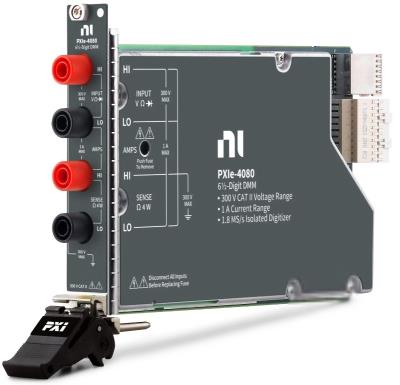
|
|
The National Instruments PXIe‑4080 is a high-performance 6½‑digit, 300 V DMM that provides the measurement capabilities found in two common test instruments: a high-resolution DMM and a digitizer. As a DMM, the PXIe‑4080 delivers fast, accurate AC/DC voltage, AC/DC current, 2‑ or 4‑wire resistance, and frequency/period measurements, as well as diode tests. In the high-voltage, isolated digitizer mode, the PXIe‑4080 can acquire waveforms at sample rates up to 1.8 MS/s.
Specifications.
DC Voltage.
ADC linearity: 0.5 ppm of reading + 1 ppm of range.
Effective common-mode rejection ratio (CMRR) (1 kΩ resistance in LO lead): >140 dB (DC), 100 ms aperture; >170 dB (>46 Hz) with high-order DC noise rejection, 100 ms aperture, typical.
Overrange: 105% of range except 300 V.
DC voltage input bias current: <30 pA at 23 °C, typical.
Ranges: 100 mV, 1 V, 10 V, 100 V, 300 V.
Resistance.
Maximum 4-wire lead resistance: Use the lesser of 10% of range or 1 kΩ.
Ranges: 100 Ω, 1 kΩ, 10 kΩ, 100 kΩ, 1 MΩ, 10 MΩ, 100 MΩ.
DC Current.
Overrange: 105% of range except 1 A range.
Ranges: 20 mA, 200 mA, 1 A.
AC Voltage.
Input impedance: 1 MΩ ± 2% in parallel with 150 pF, typical.
Input coupling: AC or DC coupled.
Overrange: 105% of range except 300 V.
Maximum Volt-Hertz product: Verified to 2.2 x 107 V-Hz.
Maximum DC voltage component: 250 V.
Common mode rejection ratio (CMRR), 1 kΩ resistance in LO lead: >70 dB (DC to 60 Hz), typical.
Ranges: 50 mV, 500 mV, 5 V, 50 V, 300 V.
AC Current.
Overrange: 105% of range except 1 A.
Ranges: 10 mA, 100 mA, 1 A.
Diode Test.
Range: 10 V.
Test current: 1 μA, 10 μA, 100 μA, 1 mA.
Accuracy: Add 20 ppm of reading to 10 VDC voltage specifications.
Frequency and Period.
Frequency measurement range: 15 Hz to 500 kHz.
Period measurement range: 2 μs to 66.67 ms.
Temperature.
Types: RTD, Thermistor, J, K, N, T, E, R, S, B.
Isolated Digitizer.
Available functions: Voltage and current.
Voltage ranges: ±100 mV to ±300 V (DC or AC coupled).
Current ranges: ±20 mA to ±1 A.
Sample rate range: 10 S/s to 1.8 MS/s.
Available sample rates: r = (1.8 MS/s) / y, where y = 1, 2, 3,...1.8 x 105.
Timebase accuracy: Equal to the PXIe_CLK100 accuracy of the chassis.
Digitizer record length: 2 samples minimum, unlimited maximum.
|